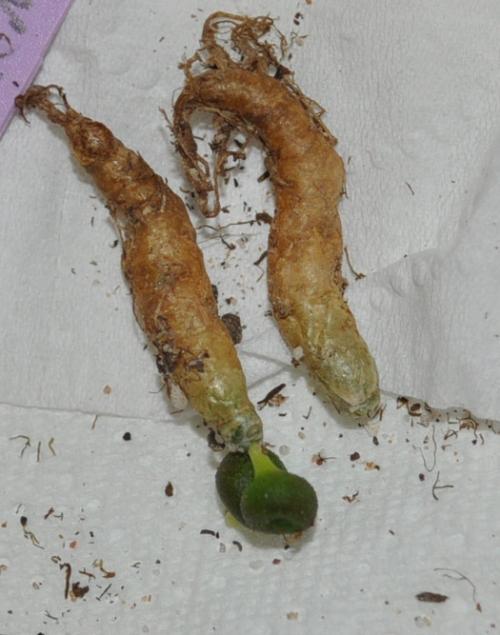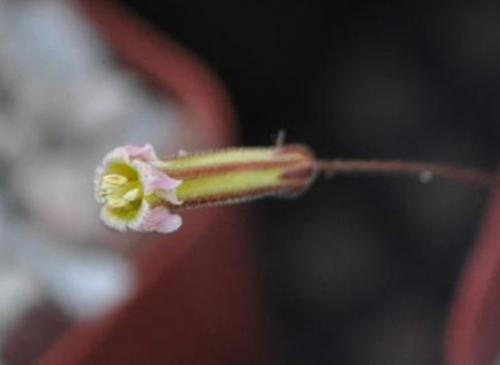OPELII Van Jaarsv. & Hammer, 2011 (engl./ fr.)
Distribution : Endemic to the northern Knersvlakte in the northern part of the Western Cape, SA; growing in quartz-gravel.
Description :
Plant solitary, summer-deiciduous, dwarf geophyte to 10 mm in diameter.
Roots fibrous.
Tuber oblong, up to 35 x 10 - 15 mm, pale grey-brown and somewhat flaking.
Leaves softly succulent, apically produced, solitary or rarely with up to 3 leaves, ascending, blade irregularly molded, broadly club-shaped, orbicular to reniform, often irregularly concave, 8 - 15 x 10 - 15 mm, cuneate and tapering to 2 - 3 mm at the base, petiole short, indistinct, 2 - 3 mm long; upper surface very dark green, lower surface flushed beet red, both surfaces slightly shining, almost glabrous but bearing minute raised pointed trichomes, margin entire.
Inflorescence a branched lax thyrse up to 10 cm long, with 1 - 2 monochasia, each with 1 - 2 flowers, faintly scented, peduncle glandular pubescent, pedicels 12 - 15 mm, bracts linear-oblanceolate, 4 - 6 x 0.3 mm, reddish-green soon deciduous.
Flowers : Calyx glandular pubescent, marron green, sepals 3 - 4 x 0.5 mm, corolla ascending, glandular pubescent, the buds white-tipped, tube 12 - 15 mm long, 2 mm at base expanding to 3 mm at throat, greenish-maroon, petals 2.5 - 3 x 1-5 mm, becoming recurved, white, apices acute.
Flowering time : January
First published in CSJ US, vol. 83 (4), 2011
-------------------------------------------------------------------------------------------------------------------
Distribution : endémique du nord du Knersvlakte, dans la partie septentrionale du Cap-Occidental, Afrique du Sud ; poussant sur gravier de quartz.
Description :
Géophyte naine et solitaire, à feuillage caduque en été, jusqu'à 10 mm de diamètre.
Racines fibreuses.
Tubercule oblong, jusqu'à 35 x 10 - 15 mm, gris-marron pâle et s'exfoliant quelque peu.
Feuilles légèrement succulentes, produites à l'apex, solitaires ou rarement au nombre de 3 feuilles, ascendantes, limbe irrégulier, largement en forme de massues, orbiculaires à réniformes, souvent irrégulièrement concaves, 8 - 15 x 10 - 15 mm, cunées et s'affinant à la base en 2 - 3 mm, pétiole court, indistinct, 2 - 3 mm de long ; dessus vert très foncé, dessous rouge betterave, les deux surfaces légèrement brillantes, presque glabres mais portant de minuscules trichomes saillants pointus, marge entière.
Inflorescence : Un thyrse lâche ramifié atteignant 10 cm de long, avec 1 - 2 monochasia, chacun portant 1 - 2 fleurs, faiblement parfumées, pédoncule à poils glandulifères, pédicelles de 12 - 15 mm, bractées linéaires-oblancéolées, 4 - 6 x 0,3 mm, vert rougeâtre, vite caduques.
Fleurs : Calice à poils glandulifères, marron-vert, sépales 3 - 4 x 0,5 mm, corolle ascendante, avec poils glandulifères, les boutons ayant l'extrémité blanche, tube 12 - 15 mm de long, 2 mm à la base, s'élargissant jusqu'à 3 mm à la gorge, marron verdâtre, pétales 2,5 - 3 x 1-5 mm, devenant recourbés, blancs, extrémités aiguës.
Période de floraison dans l'habitat : Janvier.
D'abord publié dans « Cactus and Succulent Journal (U.S.) » , vol. 83 (4), 2011.

